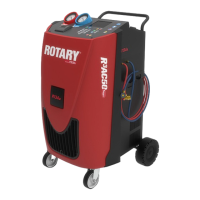4.7 Safety Precautions to follow when using the Refrigerants
Certain mixtures of air and R134a have proved to be flammable
at high pressures.
These mixtures are potentially hazardous and can cause fires
and explosions, causing personal injuries and damage to
objects.
Further safety and medical information can be obtained from the
lubricant and refrigerant manufacturers.
Safety Measures:
•
Do not use external tanks or other storage systems that have not been approved and/or that
are not equipped with safety valves.
•
Do not test the equipment or the vehicle A/C system containing R134a with compressed air.
4.8 Workplace Safety
The equipment is designed to work at a maximum altitude of
1000 m / 3281 ft above sea level, with an operating temperature
between 5 °C / 41 °F and 40 °C / 104 °F and a maximum humidity
of 50% at 50 °C / 122 °F.
Safety Measures:
•
Never, under any circumstance, use the device in an environment where there is risk of
explosion.
•
Keep the device in environments with temperatures that do not exceed 50 °C / 122 °F.
•
Only use the device in open or well-ventilated environments (at least 4 air changes per hour).
•
Make sure the workplace is well-lit (average operating illuminance, for mechanic workshops
and assembly on work benches for precision work, is 500-750-1000 lux).
4.9 Guidelines for Handling the Refrigerants Used
4.9.1 Refrigerant Storing Precautions
The device has been designed and built to operate with R134a refrigerant only.
•
The refrigerant removed from the A/C system must be handled with care to prevent the
refrigerants from mixing or in any case reduce the risk of this happening.
•
The cylinders used for refrigerant storing must be specific for each refrigerant to avoid mixing
the refrigerants.
•
The cylinders must be perfectly clean and clearly labelled in order to identify the refrigerant
they contain.
4.9.2 Refrigerant and System Conditions
The installation procedures and the maintenance carried out during the operating life of the A/C
system substantially affect the quality of the refrigerant.
Understanding these factors is essential in order to decide whether or not the refrigerant from a
system should be recycled.
12

